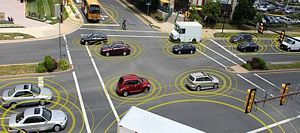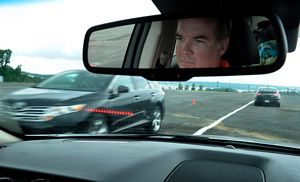|
By accessing/using The Crittenden Automotive Library/CarsAndRacingStuff.com, you signify your agreement with the Terms of Use on our Legal Information page. Our Privacy Policy is also available there. |

DOT works with world partners to improve connected vehicles, deliver safety benefits
|
|---|
|
|
DOT works with world partners to improve connected vehicles, deliver safety benefits
Fast Lane
U.S. Department of Transportation
October 23, 2012
In the past, I’ve noted the promise of connected vehicles, a network of cars, trucks and buses communicating with each other to warn their drivers when dangerous situations develop. Using wireless technology similar to the WiFi in our homes, connected vehicles provide their drivers with better information earlier so drivers can
take action to avoid a crash before it happens.
Our National Highway Traffic Safety Administration found that connected vehicles have the potential to address up to 80 percent of all unimpaired crash scenarios. And right now, the people of Ann Arbor, Michigan, are helping us learn more about the promise of this safety technology through a
community-wide pilot study.
The technology’s potential benefits to our nation extend beyond saving lives; connected vehicles will also help us relieve congestion and reduce our environmental footprint. These benefits won't be unique to the United States; the promise of connected vehicles is global.
This week the
connected vehicle community is meeting at the ITS World Congress to share knowledge and insights that can help us better realize this technology's safety promise.
America is not alone in our support of a system of vehicles and roadside equipment communicating wirelessly. Europe, Canada, Japan, and Korea all recognize the safety benefits of such technology. Because we share many of the same transportation challenges and goals with these regions, we're working with them to foster international collaborative research and widespread deployment of connected vehicles.
DOT and European Union joint efforts have resulted in the development of a common safety message that can be understood by devices in American and European vehicles with only minor modifications. This harmonization enables the use of common hardware and software and will lead to economies of scale and lower costs for products destined for both regions. And that means the technology will be developed faster, and the vehicles will be in your showroom sooner.
DOT is also collaborating with the Japanese Ministry of Land, Infrastructure, Transportation and Tourism on probe data research. Probe systems allow infrastructure to collect data such as travel speeds and crash incidents. In addition to the safety benefits of this information, probe data allow for more accurate monitoring and communicating of traffic conditions, so drivers get real-time information to help them avoid congestion and find other, faster routes to get where they need to go.
Our partnership with Japan will reduce costs for research, development, and testing of applications. Improved consistency and compatibility of data, probe systems, technology, and practices will improve the global marketability of products.
Together, your DOT and its global partners are working hard to make the future of connected vehicles a reality that much sooner. By achieving consistent standards globally, we're going to get these vehicles and the safety benefits this technology offers on your roads faster.


















 Topics: SaferBus
Topics: SaferBus



